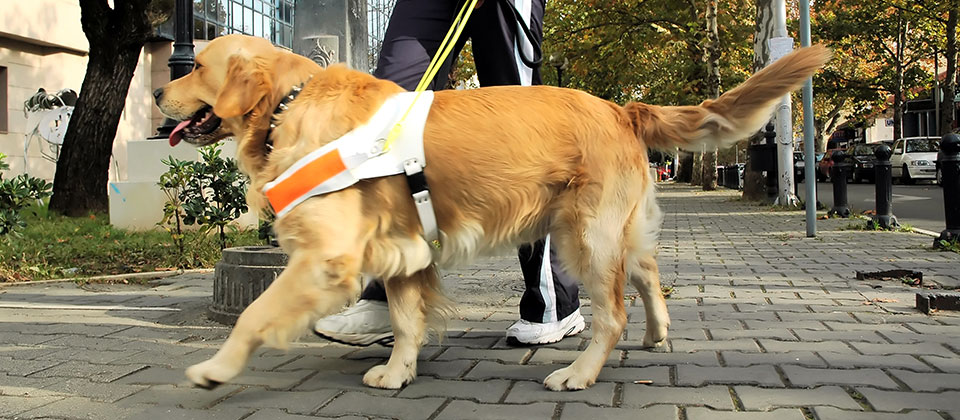There is a lot of confusion about the role of a Therapy Dog versus the role of a Service Dog.
THERAPY DOGS
Simply put, a Therapy Dog is a dog trained to provide affection and comfort to people in hospitals, retirement homes, nursing homes, schools, hospices, disaster areas, and to people with learning difficulties. Therapy dogs come in all sizes and breeds. The most important characteristic of a therapy dog is its temperament. A good therapy dog must be friendly, patient, confident, gentle, and at ease in all situations. Therapy dogs must enjoy human contact and be content to be petted and handled, sometimes clumsily.
A therapy dog's primary job is to allow unfamiliar people to make physical contact with it and to enjoy that contact. Children in particular enjoy hugging animals; adults usually enjoy simply petting the dog. The dog might need to be lifted onto, or climb onto, an individual's lap or bed and sit or lie comfortably there. Many dogs contribute to the visiting experience by performing small tricks for their audience or by playing carefully structured games. In hospice environments, therapy dogs can play a role in palliative care by reducing death anxiety. For more information on Therapy Dog training and Certification please visit our website: www.thedogknowledge.com/web/service-therapy/
SERVICE DOGS
A service dog is a type of assistance dog specifically trained to help people who have disabilities including visual difficulties, hearing impairments, mental illness, seizures, diabetes, autism, and more.
JUMP TO:
TRAITS • ETIQUETTE • TAX DEDUCTIONS • LIFE OF A SERVICE DOG
SERVICE DOG TRAITS
Desirable character traits in service animals typically include good temperament or psychological make-up and good health (including physical structure and stamina). Service dogs are often trained and bred by service dog organizations. Labrador Retrievers, German Shepherds, Golden Retrievers, are the most common breeds used as service dogs, but any breed or mix of breeds is capable of being a service dog, though few dogs have all of the health and temperament qualities needed.
In the United States, the Code of Federal Regulations for the Americans with Disabilities Act which took effect as of March 15, 2011 defines a service animal as:
Any dog that is individually trained to do work or perform tasks for the benefit of an individual with a disability, including a physical, sensory, psychiatric, intellectual, or other mental disability. Other species of animals, whether wild or domestic, trained or untrained, are not service animals for the purposes of this definition. The work or tasks performed by a service animal must be directly related to the individual's disability. Examples of work or tasks include, but are not limited to, assisting individuals who are blind or have low vision with navigation and other tasks, alerting individuals who are deaf or hard of hearing to the presence of people or sounds, providing non-violent protection or rescue work, pulling a wheelchair, assisting an individual during a seizure, alerting individuals to the presence of allergens, retrieving items such as medicine or the telephone, providing physical support and assistance with balance and stability to individuals with mobility disabilities, and helping persons with psychiatric and neurological disabilities by preventing or interrupting impulsive or destructive behaviors. The crime deterrent effects of an animal´s presence and the provision of emotional support, well-being, comfort, or companionship do not constitute work or tasks for the purposes of this definition.
This revised definition EXCLUDES all comfort animals, which are pets that owners keep with them for emotional reasons. (For example, the owner may feel calmer when he or she is near the pet). Unlike a service animal, a comfort animal is not trained to perform specific tasks directly related to the person's disability. Common tasks for service animals include flipping light switches, picking up dropped objects, alerting the person to an alarm, or similar disability-related tasks.
A service dog may still provide help to people with psychiatric disabilities, but the dog must be trained to perform specific actions, such as distracting the person when he becomes anxious or engages in other behaviors related to his disability.
Disabled owners of service dogs are protected under the Americans with Disabilities Act of 1990, which generally gives them the right to be accompanied by their service animal anywhere the general public is allowed.
SERVICE DOG ETIQUETTE
Most owners expect their service dogs to be treated as a working animal while in public. The health and safety of their owner may depend on the dog's ability to focus and resist distraction. Many service dogs are trained to avoid distraction when wearing their gear, but relax and are friendly when the gear is removed. An owner will expect to be asked for permission before another individual interacts with the dog. It is generally advisable not to interact, pet or approach a working service dog.
TAX DEDUCTIONS FOR SERVICE DOGS IN THE UNITED STATES
If you have a guide dog or service animal you are permitted to deduct the expenses related to the buying, training and maintenance of the dog or other animal. These are considered Medical Expenses and they are deductible in the United States. This includes expenses for: food; grooming; and, medical care. It is limited to guide dogs or service animals for people with visual impairments, hearing impairments or a person with another physical disability.
Additional federal laws protect people with disabilities partnered with service animals, as well as other types of assistance animals, from discrimination in housing (the Fair Housing Amendments Act) and on aircraft (the Air Carrier Access Act). Under the ADA, businesses are permitted to deny access to service dogs that are not behaving properly. They may also be excluded if the presence of the animal constitutes a fundamental alteration of the business or poses a direct threat. Persons with service dogs are not required to pay any additional fees on account of the service dog, though the owner is responsible for any damages caused by the dog.
Service dogs may wear special vests or ID tags, but they are not a requirement of the ADA.
LIFE OF A SERVICE DOG
The typical working life of a service dog is usually eight to ten years, depending on the owner's needs and preferences.
Service dogs are free to act normally when they are not working. Typically, the animals are taught to identify work versus free time by whether or not they are wearing their gear. Exceptions to this rule may exist, such as a seizure alert dog, which must not ignore an impending seizure even when it is not wearing its gear. Nevertheless, just as with any other trained animal, working dogs must still obey commands even when they are off-duty. Because of the strict behavior expected from a working dog when it is on duty, many owners will usually not permit people to pet the animal, or are reluctant to remove gear on request (such as for security inspections.)
When a service dog retires, it may remain with his owner or a family member as a pet. If the owner is unable to care for him and a successor dog at the same time, he may be returned to the program for "re-homing." Typically, the family that raised it as a puppy is given the first opportunity to keep him as a pet. Others are adopted out to carefully screened homes. These dogs are highly desirable pets because of their manners and obedience training; waiting lists for such placements may sometimes be measured in years.
Additionally, for a dog to be certified as "service dog" the dog MUST perform a service. Dogs that are placed with individuals by physicians to provide emotional support, relieve anxiety, loneliness etc. are known as emotional support animals, ESA, and cannot go into no-pets-allowed places. But they are allowed to live in "no pet" housing.


